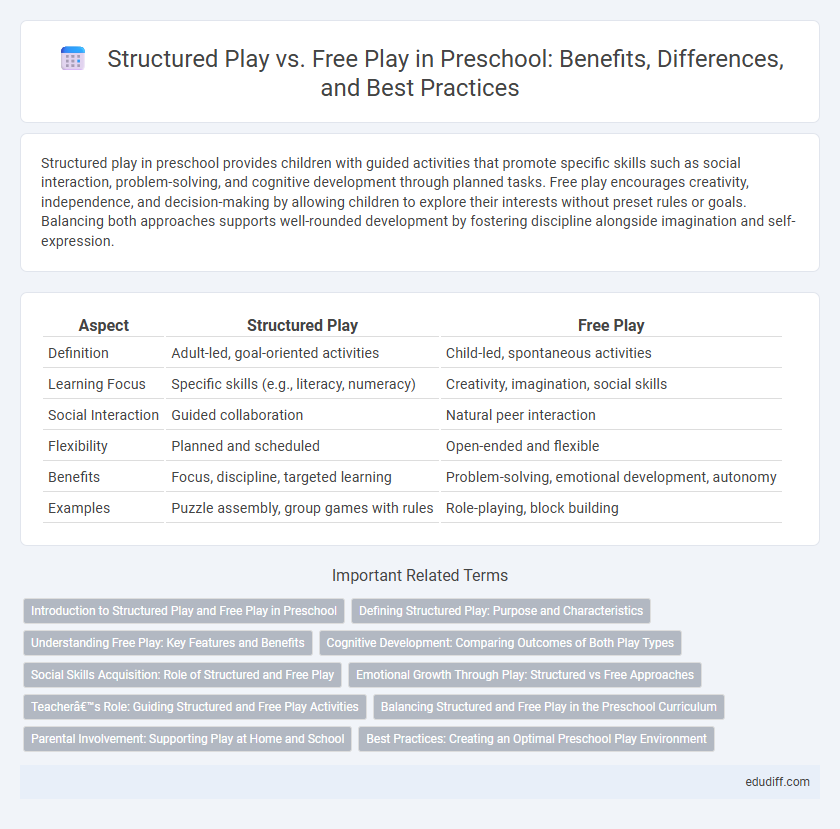Structured play in preschool provides children with guided activities that promote specific skills such as social interaction, problem-solving, and cognitive development through planned tasks. Free play encourages creativity, independence, and decision-making by allowing children to explore their interests without preset rules or goals. Balancing both approaches supports well-rounded development by fostering discipline alongside imagination and self-expression.
Table of Comparison
| Aspect | Structured Play | Free Play |
|---|---|---|
| Definition | Adult-led, goal-oriented activities | Child-led, spontaneous activities |
| Learning Focus | Specific skills (e.g., literacy, numeracy) | Creativity, imagination, social skills |
| Social Interaction | Guided collaboration | Natural peer interaction |
| Flexibility | Planned and scheduled | Open-ended and flexible |
| Benefits | Focus, discipline, targeted learning | Problem-solving, emotional development, autonomy |
| Examples | Puzzle assembly, group games with rules | Role-playing, block building |
Introduction to Structured Play and Free Play in Preschool
Structured play in preschool involves guided activities led by educators, designed to develop specific skills such as fine motor abilities, language, and social interaction. Free play allows children to explore, imagine, and interact spontaneously, fostering creativity, decision-making, and independent problem-solving. Both structured play and free play contribute uniquely to childhood development, balancing cognitive growth and emotional resilience.
Defining Structured Play: Purpose and Characteristics
Structured play in preschool is a guided activity designed to achieve specific developmental goals such as enhancing cognitive skills, social interaction, and motor abilities. It typically involves adults setting clear rules, objectives, and time limits to facilitate learning through play. Characteristics of structured play include planned interactions, targeted skill development, and organized environments that support focused and purposeful engagement.
Understanding Free Play: Key Features and Benefits
Free play in preschool fosters creativity, social skills, and emotional development by allowing children to explore interests without adult direction. It encourages problem-solving and decision-making through imaginative scenarios, enhancing cognitive flexibility. Children engaged in free play develop independence and self-regulation, critical for early learning success.
Cognitive Development: Comparing Outcomes of Both Play Types
Structured play in preschool settings promotes cognitive development by enhancing memory, attention, and problem-solving skills through guided activities and clear objectives. Free play fosters creativity, imagination, and executive functioning by allowing children to explore and make independent decisions in an unstructured environment. Research indicates a balanced approach combining structured and free play optimizes cognitive gains, supporting both analytical skills and imaginative thinking.
Social Skills Acquisition: Role of Structured and Free Play
Structured play in preschool settings fosters social skills like turn-taking, cooperation, and rule-following by providing clear guidelines and adult supervision. Free play encourages creativity, negotiation, and conflict resolution as children interact spontaneously and navigate social dynamics independently. Combining both approaches enhances overall social competence and emotional intelligence in early childhood development.
Emotional Growth Through Play: Structured vs Free Approaches
Emotional growth in preschoolers is significantly influenced by both structured and free play, with structured play providing guided opportunities for children to navigate social rules and express feelings within set boundaries. Free play encourages spontaneous emotional expression and self-regulation by allowing children to explore their interests and process emotions at their own pace. Balancing structured and free play fosters resilience, empathy, and emotional intelligence critical for early childhood development.
Teacher’s Role: Guiding Structured and Free Play Activities
Teachers play a crucial role in balancing structured and free play activities by designing intentional, developmentally appropriate tasks that promote cognitive, social, and motor skills during structured play. They observe, facilitate, and scaffold children's interactions in free play to encourage creativity, problem-solving, and peer collaboration while respecting each child's autonomy. Effective guidance involves creating a safe environment, setting clear expectations, and dynamically responding to children's needs to optimize learning outcomes in both play settings.
Balancing Structured and Free Play in the Preschool Curriculum
Balancing structured play and free play in the preschool curriculum enhances cognitive and social development by providing children with guided learning opportunities alongside creative exploration. Structured play, guided by educators, promotes skills such as problem-solving and cooperation, while free play fosters imagination, autonomy, and emotional regulation. Optimal preschool programs incorporate both to support well-rounded growth and prepare children for future academic and social success.
Parental Involvement: Supporting Play at Home and School
Parental involvement enhances the benefits of both structured and free play by creating a supportive environment at home and school that encourages learning and creativity. Structured play guided by caregivers promotes skill development and goal-oriented tasks, while free play allows children to explore and express themselves independently under parental observation. Consistent parental engagement fosters emotional security, social skills, and cognitive growth through balanced exposure to diverse play types.
Best Practices: Creating an Optimal Preschool Play Environment
Creating an optimal preschool play environment balances structured play, which promotes cognitive skills through guided activities, and free play, essential for fostering creativity and social development. Best practices include providing diverse, age-appropriate materials that encourage exploration while allowing flexibility for child-led interactions. Educators should design spaces that promote safety and accessibility, supporting both intentional learning goals and spontaneous imaginative play.
Structured Play vs Free Play Infographic

 edudiff.com
edudiff.com